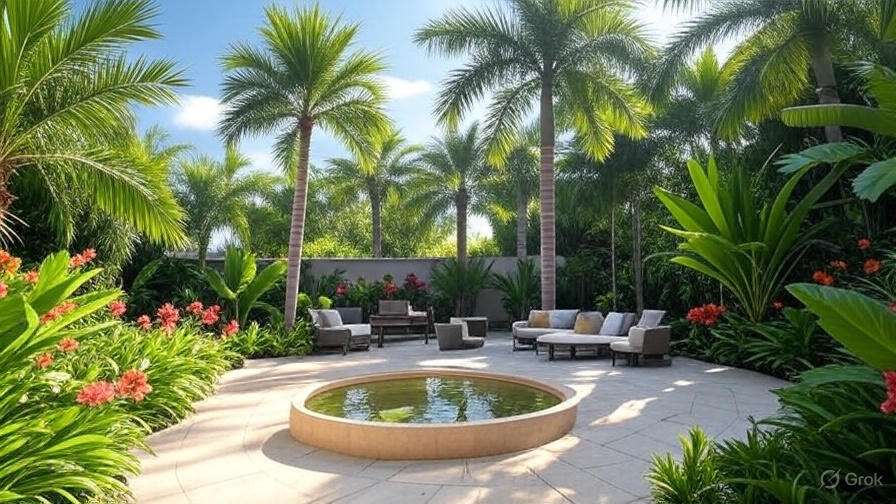
How to Choose the Best Miami Palm Trees for Your Yard: A Complete Guide
When it comes to transforming your yard into a tropical oasis, nothing quite compares to the elegance and charm of Miami palm trees 
This complete guide will walk you through everything you need to know about selecting the best palm trees for your outdoor space—no green thumb required! From climate considerations to aesthetic appeal, we’ll cover all the essentials, ensuring that your palm trees not only look stunning but also grow strong and healthy. If you’re ready to elevate your landscape with the perfect Miami palms, keep reading!
Table of Contents
ToggleUnderstanding Miami Palm Trees 
When it comes to transforming your Miami yard into a tropical paradise, choosing the right palm trees is essential! With its sunny climate and coastal beauty, Miami is home to many types of palm trees, each offering unique benefits to your landscape. Whether you’re going for a classic beach look or a more exotic vibe, understanding the different types of Miami palm trees will help you make the best choice for your space.
What Are Miami Palm Trees? 
Miami palm trees are more than just a beautiful addition to your yard—they’re a defining feature of Florida’s tropical landscape. Known for their tall trunks, lush green fronds, and ability to thrive in the city’s sunny, humid climate, these palms are the perfect way to bring a piece of paradise to your home.
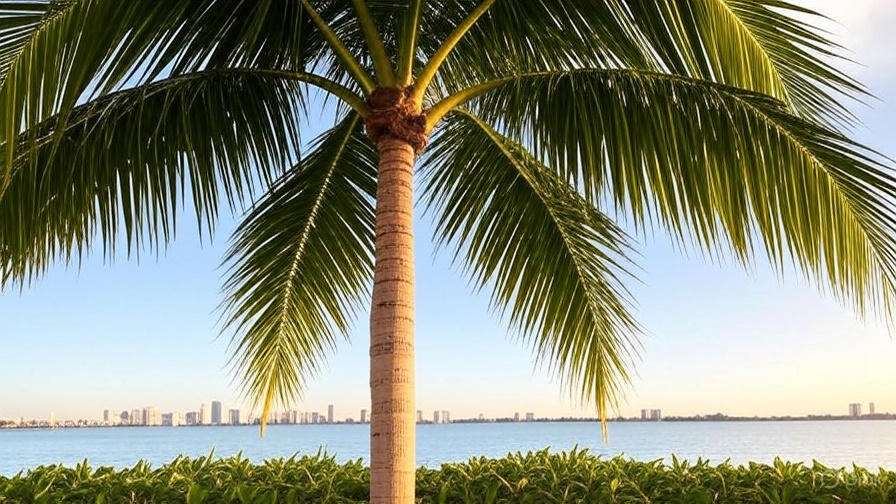
Why Miami Palm Trees Matter 
In Miami, palm trees do more than beautify the surroundings. They’re incredibly well-suited to the area’s warm, subtropical weather. These palms add instant curb appeal, offer shade, and create that iconic vacation vibe you associate with the city’s beaches and outdoor lifestyle.
Whether you’re looking to line your driveway, frame your garden, or create a private oasis in your backyard, Miami palm trees provide a practical and aesthetic solution. Plus, they’re low-maintenance, making them ideal for homeowners who want to enhance their landscape with
Why Choose Palm Trees for Your Yard?
Palm trees offer a unique beauty and tropical feel that’s hard to match. They’re low-maintenance, drought-tolerant once established, and can transform any outdoor space. Whether you want a tall, stately tree for shade or a small, ornamental palm to add flair, there’s a variety for every need.
Key Factors to Consider Before Planting Palm Trees in Miami
When selecting a palm tree, it’s important to consider your yard’s size, soil type, and how much sunlight the area gets. Not all palms thrive in the same conditions, so understanding what works best in your environment will set you up for success.
- Size: Some palms grow tall (up to 50 feet!), while others stay compact. Make sure to pick a palm that suits the space you have.
- Sunlight: Most palms thrive in full sun, but some like partial shade. Check how much direct sunlight your yard gets before choosing your palm.
- Watering Needs: While many palms are drought-tolerant once established, they’ll still need regular watering when young. Be mindful of your local rainfall patterns.
- Soil: Palms generally prefer well-draining soil. In Miami, sandy soil is common, which is great for many palm species.
- To keep your palms looking their best, follow these simple care tips:
By understanding the unique characteristics of Miami palm trees and how to care for them, you’ll be well on your way to creating a stunning tropical landscape that enhances your yard.
out too much effort.
Factors to Consider When Choosing Miami Palm Trees 
Choosing the right palm tree for your Miami yard is crucial to creating a beautiful and thriving outdoor space. The warm, tropical climate of Miami offers a perfect environment for palm trees, but not all palms are created equal. Here are some key factors to consider to ensure you make the best choice for your yard:
1. Climate Suitability 
Miami’s subtropical climate means you’ll want a palm that thrives in hot, humid conditions with occasional rainfall. Most Miami palm trees are well-suited to this, but it’s important to pick one that can handle both the summer heat and the rare cold snaps. Some palms, like the Royal Palm or Queen Palm, are known for their resilience to Miami’s warm climate.
2. Size and Space Available 
Not all palms are the same size, and it’s essential to choose one that fits your yard space. Smaller varieties like the Pygmy Date Palm are perfect for compact spaces, while larger palms, such as the Coconut Palm, need room to grow. Make sure to measure the space available and consider the height and spread of the palm at maturity.
3. Maintenance Needs 
Some palms require more care than others. If you’re looking for a low-maintenance tree, palms like the Saw Palmetto or Cabbage Palm are great choices. They require little pruning and are more resistant to pests and diseases. On the other hand, palms like the Foxtail Palm might need a bit more attention but are still relatively easy to manage.
4. Aesthetic Appeal 
The look and feel of the palm tree can have a huge impact on your yard’s overall aesthetic. Do you want a tropical, exotic vibe, or something more formal and structured? Tall, elegant palms like the Royal Palm offer a dramatic focal point, while smaller, bushier palms like the Mexican Fan Palm create a more natural, tropical feel. Choose a style that complements your landscape design!
5. Watering and Irrigation 
Although Miami gets plenty of rain, some palms still require supplemental watering during dry spells. Be mindful of the watering needs of your chosen palm. Palms like the Sabal Palm are drought-tolerant once established, while others, like the Majestic Palm, need more frequent watering. Check your irrigation system and plan accordingly to keep your palm happy.
6. Soil Type and Drainage 
Palm trees need well-draining soil to prevent root rot. Miami’s sandy soil is usually perfect for palms, but make sure the planting site has good drainage. If your soil is heavy or clay-like, amend it with organic matter to improve drainage. The Windmill Palm is a great choice for slightly different soil conditions, adapting well to a variety of environments.
7. Pest and Disease Resistance 
In Miami, palm trees can be susceptible to pests like the Palm Weevil or fungal infections. To avoid problems, choose palms that are known for their pest and disease resistance. Canary Island Date Palms and Cabbage Palms are more resilient to common pests. Be proactive with regular inspections and maintenance to keep your palm healthy.
8. Longevity and Durability 
Some palm trees live for many decades, while others are shorter-lived. If you’re looking for a long-term investment, consider palms that are known for their durability, such as the Coconut Palm or Bismarck Palm. These trees not only look stunning but can stand the test of time with proper care.
Choosing the right palm tree for your Miami yard doesn’t have to be overwhelming. By keeping these factors in mind, you’ll be able to select a palm that thrives in Miami’s climate, fits your space, and complements your personal style. 

Popular Miami Palm Trees and Their Benefits 
Miami is famous for its tropical vibes, and nothing says “Miami” quite like the palm trees that dot the skyline and beaches. Whether you’re looking to add a tropical touch to your yard or you need shade in the hot Miami sun, choosing the right palm tree can make all the difference. Let’s explore some of the most popular Miami palm trees and the benefits they bring to your outdoor space.
1. Coconut Palm Tree (Cocos nucifera) 
The Coconut Palm is a Miami classic. With its tall, elegant trunk and iconic fronds, it instantly gives your yard that “beachy” vibe.
Benefits:
- Tropical Aesthetic: Perfect for creating a laid-back, vacation-like atmosphere.
- Shade: Provides shade, especially in areas that get a lot of direct sunlight.
- Coconuts: If you’re lucky, you might even get coconuts for drinks or decoration!
Considerations: Requires full sun and well-drained soil. It’s also more suited to coastal areas due to salt tolerance.
2. Royal Palm (Roystonea regia) 
A true symbol of elegance, the Royal Palm stands tall with its smooth trunk and fan-shaped leaves. It’s often seen lining Miami’s streets and makes a statement in any yard.
Benefits:
- Impressive Look: Its towering presence is perfect for making a bold impression.
- Low Maintenance: Tolerates a wide range of conditions and grows well in full sun.
- Adds Value: Can increase the aesthetic value of your property.
Considerations: Requires plenty of space to grow and thrive.
3. Areca Palm (Dypsis lutescens) 
If you want a smaller, bushier palm for your yard, the Areca Palm is a fantastic choice. It’s known for its dense, feathery fronds and vibrant green color.
Benefits:
- Privacy Screen: Plant them in clusters for a natural privacy hedge.
- Versatile Size: Can be grown in smaller yards or even in pots.
- Low Maintenance: Very easy to care for and tolerates indirect sunlight.
Considerations: It needs occasional pruning to maintain its shape and prevent it from becoming too dense.
4. Queen Palm (Syagrus romanzoffiana) 
The Queen Palm has a graceful appearance with long, feathery fronds that droop elegantly. It’s one of Miami’s favorite palms due to its beauty and adaptability.
Benefits:
- Tropical Appeal: Perfect for adding a lush, tropical look to your yard.
- Fast-Growing: You’ll enjoy quick results, with this palm growing up to 2 feet per year.
- Colorful Berries: It produces vibrant orange berries, adding an extra pop of color.
Considerations: Needs a bit of attention when young but is generally low-maintenance once established.
5. Sabal Palm (Sabal palmetto) 
The Sabal Palm is a native palm tree of Florida, and it’s known for its sturdy trunk and fan-shaped leaves. It’s ideal for a natural, rugged look in your yard.
Benefits:
- Native to Florida: Perfect for local climates and resistant to hurricanes and storms.
- Wildlife-Friendly: Provides shelter for local birds and animals.
- Low Water Needs: More drought-tolerant than other palms.
Considerations: It grows slower than some other palms, but it’s long-lasting and low-maintenance.
6. Phoenix Palm (Phoenix canariensis) 
The Phoenix Palm, also known as the Canary Island Date Palm, is a stunning palm tree with a tall, stately trunk and large, arching fronds.
Benefits:
- Dramatic Look: Its large fronds make it an eye-catching feature in your landscape.
- Versatile Size: Can grow tall but also manageable in smaller sizes.
- Disease-Resistant: More resistant to common pests and diseases.
Considerations: Requires well-drained soil and full sun to thrive.
Final Tips for Choosing the Right Palm Tree 
- Consider Your Space: Make sure to choose a palm that suits the size and conditions of your yard.
- Water and Sun Needs: Know how much sunlight and water your palm tree will need. Some palms prefer full sun, while others tolerate shade better.
- Maintenance: Some palms require more care than others, so be sure to choose one that matches your ability to maintain it.
No matter which palm you choose, adding one to your yard is a simple way to bring a piece of paradise into your home. With the right palm tree, you’ll enjoy the beauty of Miami’s tropical environment year-round!
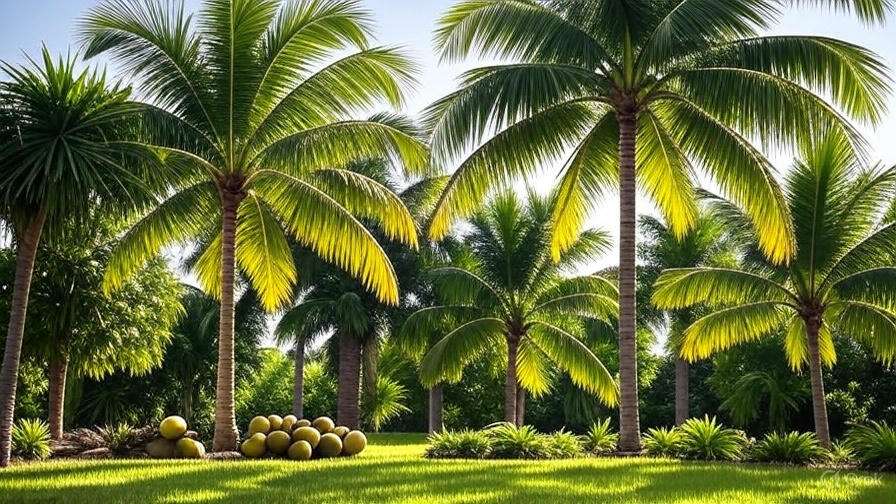
Planting and Caring for Miami Palm Trees 
When it comes to planting and caring for palm trees in Miami, the tropical climate offers a perfect environment for a variety of palm species to thrive. Whether you’re new to gardening or an experienced plant lover, here’s a simple guide to ensure your palm trees grow strong, healthy, and beautiful in your yard.
1. Choose the Right Location 
Before planting, it’s crucial to pick the right spot. Miami palms love sunlight, so choose an area that receives at least 6 hours of direct sunlight each day. Ensure that the ground is well-draining—palms don’t like soggy roots. Avoid planting in low-lying spots where water can collect after rain.
2. Preparing the Soil 
Palm trees thrive in slightly acidic, well-draining soil. If your soil is heavy or clay-based, consider mixing in sand or organic matter to improve drainage. This helps the roots grow freely and prevents water from pooling, which can cause root rot. A soil test can help you determine if amendments are needed for optimal growth.
3. Planting Your Palm 
Dig a hole twice as wide as the root ball but no deeper than the palm’s container. Place the palm in the hole, ensuring that the top of the root ball is level with the surrounding soil. Backfill with soil, packing gently to eliminate air pockets. Water immediately after planting to help the roots settle in.
4. Watering 
Proper watering is essential for palm health, especially during the first few months. Water your palm tree deeply and regularly, particularly during dry spells. However, make sure not to overwater. Let the top 2 inches of soil dry out between waterings to avoid waterlogging. Once established, most palms are relatively drought-tolerant, but consistent watering will promote healthy growth.
5. Fertilizing 
Palm trees need specific nutrients to thrive. Use a balanced, slow-release fertilizer designed for palms. Apply it in the spring and again in mid-summer. Palms need potassium, magnesium, and other micronutrients, so make sure your fertilizer contains these essential elements. Over-fertilizing can harm your palm, so always follow the manufacturer’s instructions.
6. Pruning and Maintenance 
While palms don’t require frequent pruning, removing dead or damaged fronds is essential for both health and aesthetics. Always cut fronds at the base of the tree, avoiding cutting too many at once. Don’t trim the crown or the growing tip, as this can damage the palm.
7. Protecting from Pests and Diseases 
Palms are generally low-maintenance, but they can still fall prey to pests like scale insects or fungal infections. Regularly check the fronds for signs of pests or disease, and treat them promptly with organic insecticides or fungicides. Prevent disease by keeping the base of the tree clean and avoiding excess moisture around the trunk.
8. Winter Care 
Miami doesn’t get cold often, but occasional chilly temperatures can affect palm trees. If a cold snap is expected, protect your palm by wrapping the trunk with burlap or using frost blankets to shield it from frost damage. However, most Miami palms are naturally hardy enough to withstand short periods of cool weather.
By following these simple tips, you can ensure your Miami palm trees flourish for years to come, adding a tropical touch to your home!
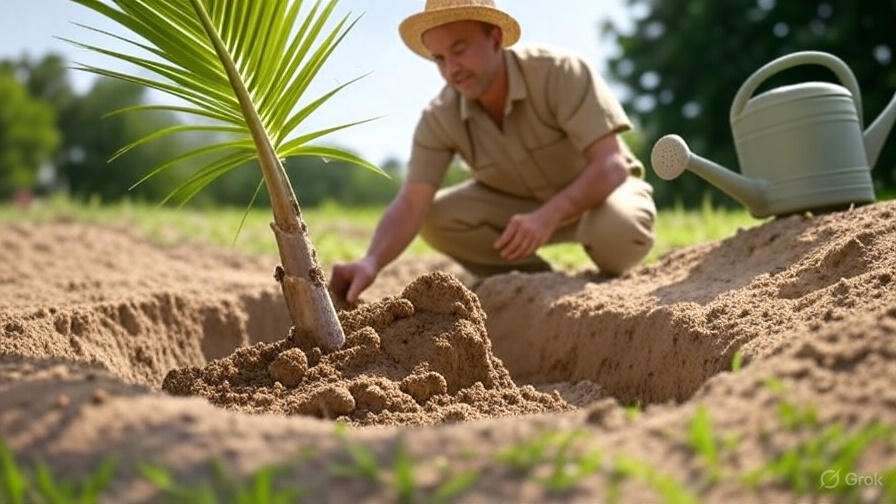
Troubleshooting Common Issues with Miami Palm Trees 
Miami’s tropical climate is perfect for palm trees, but even these resilient beauties can face some challenges. Whether you’re a seasoned gardener or a beginner, here are some common issues you might encounter with your Miami palm trees and how to solve them.
1. Yellowing or Browning Leaves 
One of the most common issues with palm trees is yellowing or browning leaves. This could be caused by several factors:
- Nutrient Deficiency: Palms need specific nutrients like potassium, magnesium, and nitrogen. A balanced palm fertilizer can help keep them healthy.
- Watering Problems: Overwatering or underwatering can stress the tree. Make sure your palm tree is planted in well-drained soil, and water it deeply but infrequently.
- Pests: Check for tiny insects like spider mites or scale. If you spot any, treat with an organic insecticide or neem oil.
2. Pests and Diseases 
Miami’s warm weather creates a perfect environment for pests like aphids, mealybugs, and the infamous palm weevil. You might notice holes in the leaves, black sooty mold, or wilting. Here’s how to tackle them:
- Regular Inspection: Check your palm regularly for pests or disease signs. Early detection makes treatment easier.
- Neem Oil: This natural remedy works wonders for pest control. Simply spray it on affected areas every few weeks.
- Proper Care: A well-maintained palm is less susceptible to pests. Ensure it’s not overwatered, which creates an ideal breeding ground for harmful insects.
3. Root Rot 
Root rot happens when palms are overwatered or the soil doesn’t drain well. It can cause wilting, yellow leaves, and a general decline in health. To prevent or fix root rot:
- Well-Drained Soil: Plant your palm in a location where water won’t pool. Adding sand or perlite to your soil can improve drainage.
- Avoid Overwatering: Water your palm only when the top few inches of soil are dry to the touch.
- Remove Damaged Roots: If you suspect root rot, gently dig around the root ball and remove any mushy or blackened roots. Repot your palm in fresh, well-draining soil.
4. Too Much Sun or Shade 

While palm trees love sunlight, too much direct sunlight can scorch their leaves. Conversely, not enough sun can cause stunted growth. Here’s how to get it right:
- Choose the Right Spot: Most Miami palms prefer full sun, but some varieties (like the Lady Palm) thrive in partial shade. Research your specific palm species for optimal light conditions.
- Gradual Acclimatization: If your palm has been kept indoors or in low light, introduce it to direct sunlight slowly to avoid sunburn.
5. Nutrient Imbalance 
Nutrient deficiencies or imbalances can stunt growth or cause discolored leaves. To ensure your palm thrives:
- Fertilize Regularly: Use a slow-release palm fertilizer to provide essential nutrients. Apply it during the growing season (spring through fall).
- Check Soil pH: Palms prefer slightly acidic to neutral soil (pH 6.0–7.5). If your soil is too alkaline or too acidic, adjust it with soil amendments.
6. Transplant Shock 
If you’ve recently transplanted a palm, you might notice some drooping or browning leaves. This is common and can happen as the palm adjusts to its new location. To minimize transplant shock:
- Proper Digging: When moving a palm, make sure you dig up enough of the root ball without damaging the roots.
- Watering: After transplanting, water your palm thoroughly and regularly to keep the roots moist.
- Mulching: Apply mulch around the base to retain moisture and protect the roots during the transition.
7. Cold Damage 
Miami palms are used to the heat, but they can still suffer during unexpected cold snaps. You may notice damaged or dead fronds if temperatures dip too low. Here’s how to protect your palms:
- Covering: When cold weather is expected, wrap your palms with frost cloth or burlap to protect them from the chill.
- Positioning: Plant palms in locations that provide some shelter from the wind, such as near buildings or fences, to reduce exposure to cold air.
By addressing these common issues with proactive care, you can keep your Miami palm trees thriving year-round!
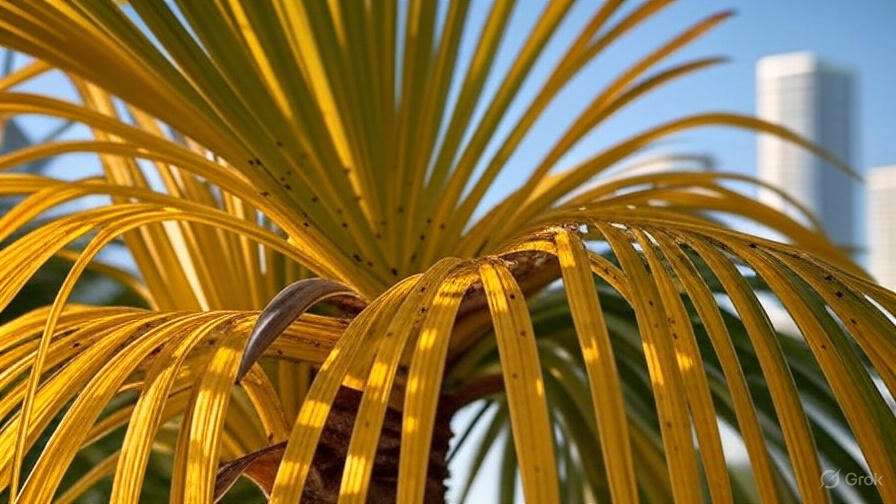
Palm Tree Landscaping Ideas 
When it comes to landscaping with palm trees, creating a tropical oasis in your own yard is easier than you think. Miami’s warm climate makes it the perfect place for a variety of palm species, and with the right ideas, you can transform any outdoor space into a relaxing retreat. Here are some expert tips and palm tree landscaping ideas to help you design the perfect yard.
1. Go for a Tropical Look with Cluster Planting 
One of the best ways to showcase Miami’s palm trees is by grouping them together. Cluster planting creates a lush, island-like vibe, especially when paired with other tropical plants like hibiscus or bird of paradise. Consider placing different palm varieties in groups to create layers of texture and height. This design works well in large yards or along property lines for added privacy.
2. Create a Statement with Single Palm Trees 
If you want to make a bold statement, consider planting a single, tall palm as a focal point. A majestic palm like the Queen Palm or Coconut Palm stands out beautifully against your lawn, creating an elegant and modern look. Plant it near your patio, entrance, or pool to draw attention and elevate the space.
3. Use Palms as Natural Privacy Screens 
Miami palm trees are perfect for creating natural privacy screens. If you have neighbors close by or simply want to block out unwanted views, plant palm trees like the Royal Palm or Foxtail Palm in a row. Their tall, lush fronds will give you a tropical barrier while still allowing breezes to flow through.
4. Mix Palms with Colorful Flowers 
Palms thrive alongside vibrant flowering plants, enhancing the tropical aesthetic. Try planting colorful flowers like bougainvillea, plumeria, or orchids around your palm trees to add pops of color and texture. These flowers will bloom beautifully against the backdrop of your palms, creating a vibrant, eye-catching landscape.
5. Palm Trees Along Pathways and Driveways 
Line your garden paths or driveway with palms to give your yard a welcoming, tropical feel. Planting palms like the Needle Palm or Pygmy Date Palm along these areas adds elegance and charm. The symmetrical lines of palm trees will also create a beautiful visual appeal, guiding guests through your outdoor space.
6. Layer Palms with Groundcover and Shrubs 
Mixing different levels of greenery is key to a balanced landscape. Add groundcovers, shrubs, or small tropical plants around your palm trees to fill in the gaps and add dimension. Varieties like the Dwarf Palmetto or Bird of Paradise work well as companions. This layered effect will keep your garden looking lush and full, with your palms taking center stage.
7. Palm Trees Around Pools and Water Features 
Palm trees naturally complement poolside landscapes and water features, making them perfect for creating a relaxing, resort-style backyard. Choose palms that tolerate wet conditions, like the Cabbage Palm or Sabal Palm, and plant them near your pool or fountain to enhance the tropical ambiance.
8. Go Minimalist with Low-Maintenance Palms 
If you prefer a low-maintenance landscaping solution, opt for palm trees that require minimal care, like the Sago Palm or Mediterranean Fan Palm. These palms thrive with little attention, offering a sleek and modern look without the need for constant pruning or upkeep. Pair them with simple, clean lines for a minimalist design that still feels chic.
9. Incorporate Palms into Container Gardens 
For those with smaller yards or even balconies, container gardening with palm trees is a great option. Pots and containers filled with palms like the Parlor Palm or Lady Palm are perfect for creating a tropical oasis in a limited space. You can place these containers along your porch, patio, or even inside for a touch of greenery.
10. Combine Palms with Hardscaping Elements 
To make your palm trees pop, combine them with hardscaping elements like rocks, stone paths, or decorative walls. A backdrop of stone or a tropical rock garden will create contrast and emphasize the natural beauty of the palms. This approach works especially well in larger landscapes where you want to highlight the palms’ striking fronds.
By using these palm tree landscaping ideas, you can easily enhance your yard and embrace the tropical beauty that Miami’s climate offers. Whether you’re creating a secluded getaway or adding some flair to your outdoor space, palm trees are a fantastic choice for any yard.
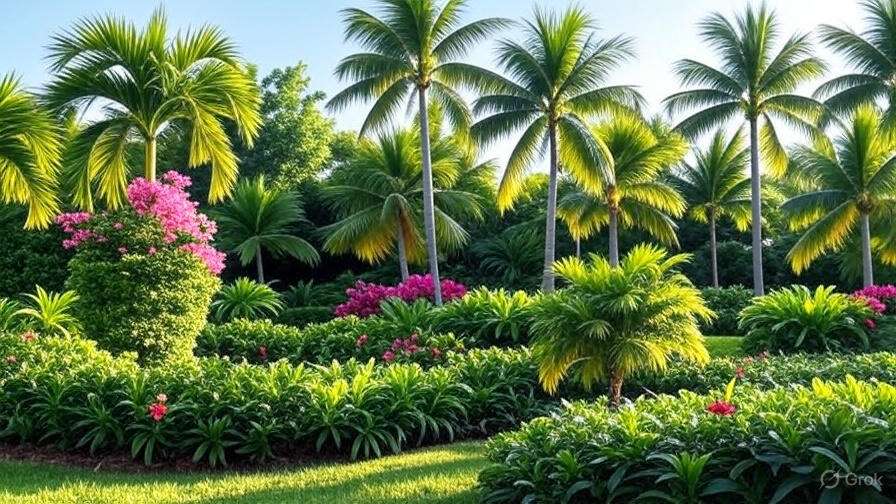
Conclusion 
Choosing the right Miami palm trees for your yard can truly transform your outdoor space into a stunning tropical paradise. By considering factors like climate compatibility, yard size, sunlight needs, and maintenance requirements, you can select the perfect palms that will thrive and enhance the beauty of your landscape for years to come.
Remember, each palm tree variety offers its own unique benefits, whether you’re after the towering elegance of a Royal Palm or the compact charm of a Pygmy Date Palm. With the right care—proper watering, fertilizing, and occasional pruning—you’ll enjoy the beauty of Miami’s most iconic trees right in your own yard.
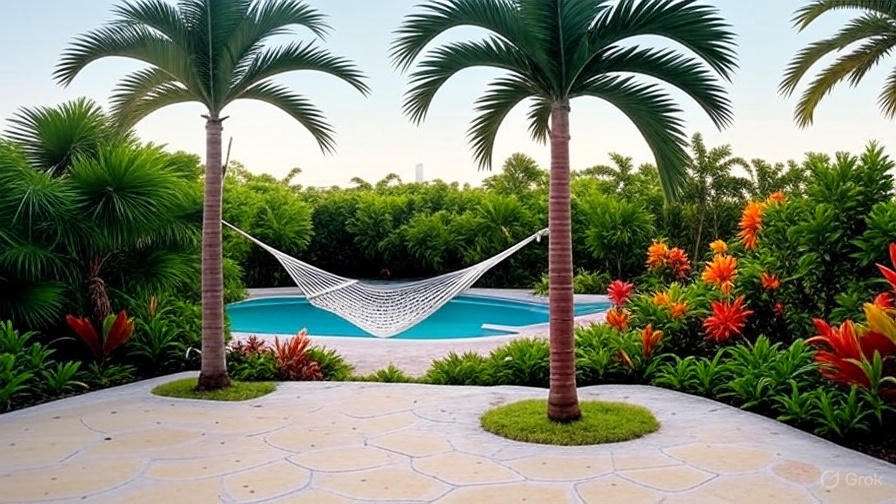
So, why wait? Start designing your own Miami-inspired oasis today and create a lush, tropical haven that reflects your personal style and the vibrant spirit of Miami!
Frequently Asked Questions (FAQs)
What’s the best palm tree for a small yard in Miami?
For a small yard, the Pygmy Date Palm is an excellent choice. It’s compact, slow-growing, and thrives in both sun and partial shade, making it perfect for tight spaces. Plus, it adds a tropical touch without overwhelming the area.
Can I grow a Coconut Palm in a small yard?
Coconut palms generally need plenty of space to grow due to their height and spread. However, you can opt for Dwarf Coconut Palms, which are more suitable for smaller yards. They still provide the classic coconut tree look but are more manageable.
How do I know if my Miami palm tree is getting too much sun?
If you notice browned or scorched fronds, it could be a sign that your palm tree is exposed to too much direct sunlight. Some palm varieties, like the Queen Palm, prefer partial shade, especially during the hottest part of the day.
What type of soil do Miami palm trees need?
Most Miami palm trees thrive in well-drained soil. Sandy or loamy soil with good drainage helps prevent waterlogging, which can harm the roots. Make sure your soil isn’t too heavy or clay-like for optimal growth.
How often should I water my Miami palm tree?
Miami palm trees generally prefer a moderate watering schedule. Water them deeply once a week, or more frequently during dry spells. Be sure the soil is dry to the touch before watering again to avoid overwatering.
What’s the best time of year to plant Miami palm trees?
The ideal time to plant Miami palm trees is in the spring or early summer when the weather is warm, and the trees have enough time to establish their roots before cooler temperatures arrive. Avoid planting during the winter months when growth slows down.
How can I protect my Miami palm tree from cold weather
While Miami palm trees are generally heat-tolerant, they can suffer from cold snaps. If a cold front is approaching, you can cover the palms with burlap or frost cloth to protect them from frost damage. Additionally, avoid planting cold-sensitive palms in areas where temperatures frequently dip below 40°F (4°C).
Do I need to prune my Miami palm trees?
Regular pruning helps keep your Miami palm trees looking their best. Remove dead or damaged fronds to maintain a clean, healthy appearance and encourage new growth. Be sure to use clean, sharp pruning tools and avoid cutting too much off at once.



